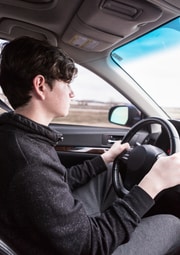How Parents Can Help Teens Develop Safe Driving Habits
Is your teen ready for the freedom and responsibility of driving? Teens are more likely to crash than adults, as they have less experience behind the wheel and are more susceptible to peer pressure. Today, we’ll go through some ways you can help your teen become a safe driver.
Before Driver’s Ed and study guides, teaching your teen about cars and safe driving habits begins with you emulating them yourself.
Be the Driver You Want Them To Be
Be mindful of what you are showing them as okay to do when they drive- buckle up, don’t text and drive, don’t talk on their phone, watch the speed limits, and drive defensively. Also, take the time to explain to your teen why certain rules are so important as you drive.
Avoid Distracted Driving
Distracted driving is anything that takes your eyes off the road, like texting, fiddling with the radio, or turning to talk to someone in the back seat. The National Highway Traffic and Safety Administration explains the risk of distracted driving by stating “Sending or reading a text takes your eyes off the road for 5 seconds. At 55 mph, that’s like driving the length of an entire football field with your eyes closed.”
Because of this risk, many driver laws restrict teens from using phones or hands-free devices until they reach a certain point in their Graduated Driver’s Licence (GDL) program. But this is not enough to keep kids from using their phones while driving – the use of mobile phones is common, and the problem only seems to be increasing.
Make sure your teen knows how to pull over for urgent calls, refrain from distracting them as they drive, and make sure they are comfortable keeping their attention on the road before letting them drive unsupervised with friends. Also, be a good role model and don’t drive distracted yourself.
Teach them about Drugs and Alcohol
All 50 states have laws that require teens to have an absolute zero alcohol level in their blood when they are in a vehicle. Teach your teen about the dangers of drunk driving and the best ways to arrange for alternate transportation. Although you don’t believe it’s something your kid would do, you never know what might happen. Teens make mistakes and are susceptible to peer pressure. Remember, about 10,000 Americans lose their lives each year due to drunk driving, many of those teens.
In addition, it’s good to go through the effects of medicines and driving. Go through any medications they may take, such as allergy or cold medications, and explain that these can cause drowsiness and may need to be timed. If you don’t know the effects of their medications, you have the web readily available!
Consider the Use of Monitoring Tools
When you can’t be in the car with your teen, there are methods to monitor their driving at all times. One way is through a parental control app that monitors driving through your teens phone. These apps provide data on the use of the vehicle, including where it’s been and current location. Other technology tool is the use of a GSP tracker, which is installed in the vehicle to monitor it’s use regardless of who the driver is.
Invest in Proper Driver’s Education
Driver’s education courses are designed to help teach your teen how to drive safely and follow your state laws. They help teenagers go through the Driver’s Handbook in an easy-to-understand format, which is very important when it later comes to driving. Make sure your teen takes a driver’s ed course even if your state does not mandate it for their permit and license. You can also take this opportunity to teach them the basics of auto insurance and get them a learner’s permit insurance.
Remember, all drivers education it’s not good drivers education. Look for courses created by professionals or those that are taught by driving experts (generally the established sites), it will be worth the extra investment.
You should also make sure that your teen does at least a few online DMV practice tests like this one. These will help identify any weak areas that may have been overlooked in driver’s education.
Teach Them to Drive Under Many Circumstances
Once they have their permit, take them to drive in various weather conditions and times of the day.
- Help them troubleshoot how to deal with light in their eye.
- Point out safe places to stop if they get in wicked weather, need to answer a call, or find themselves drowsy driving.
- Coach them on driving speeds in rain and on highways.
- Have them park on hills.
- Explain the importance of adapting to the driving conditions and general guidelines for driving in poor weather conditions or at night.
When it’s time for your teen to drive alone, you want them to feel comfortable behind the wheel. Stress leads to mistakes, and mistakes lead to accidents. Try to go through as many different situations as possible.
Make Sure They Buckle Up
According to the National Highways Traffic Safety Administration, 45% of teens that died in road accidents in 2019 were not wearing a seatbelt. Seatbelts help save thousands of lives each year. If you don’t buckle up, even minor accidents can prove to be fatal.
Make sure to buckle up as soon as you get into the vehicle, no matter the distance of the trip. This will help create a strong habit that your teen will continue to follow.





